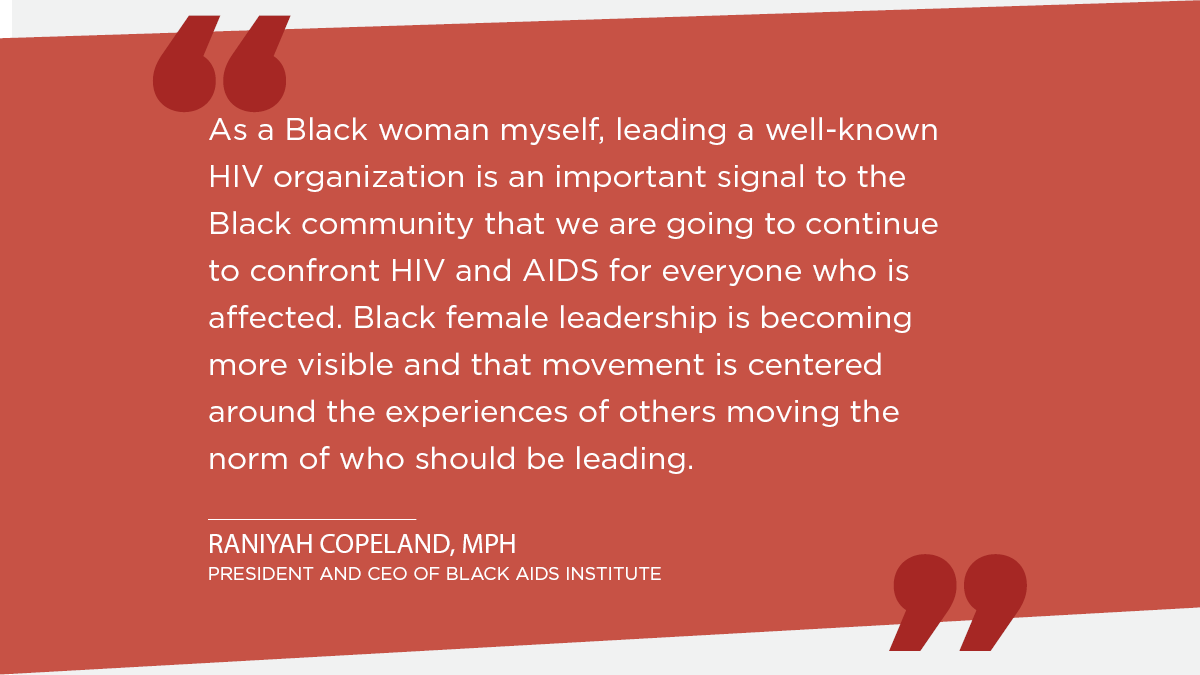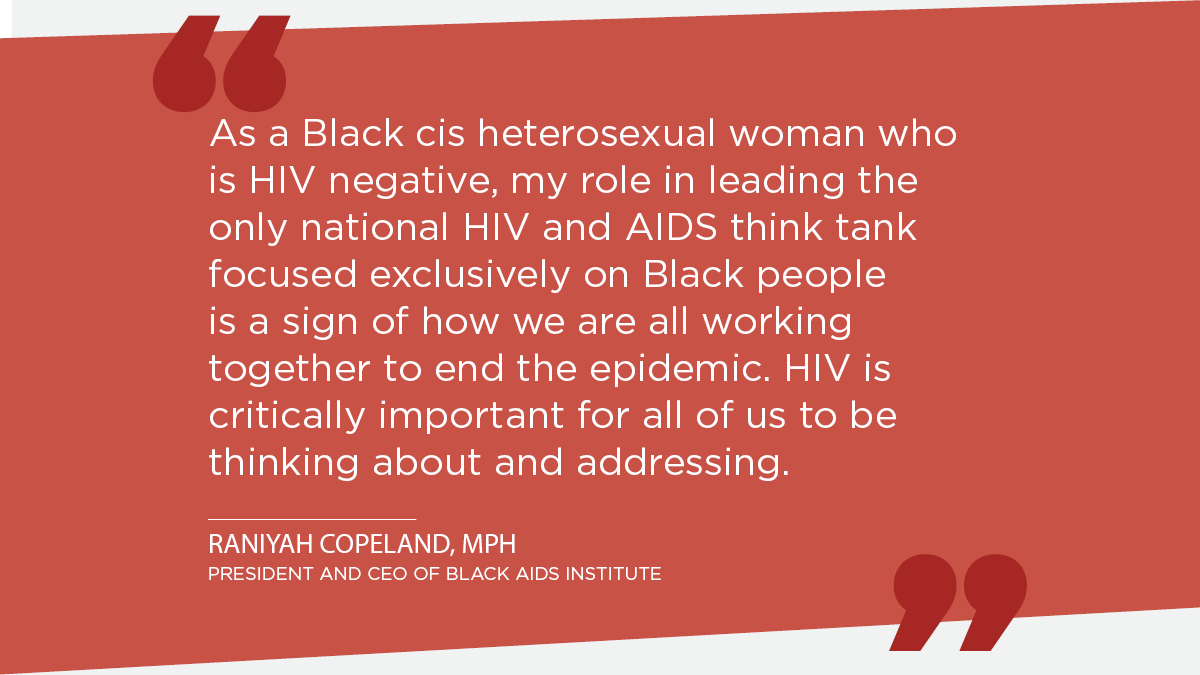AIDSVu spoke with Raniyah Copeland, President and CEO of Black AIDS Institute.
Q: You have been with Black AIDS Institute since 2008 and were recently chosen to be the new President and CEO. What is your vision for the future of Black AIDS Institute and for the future of efforts to end HIV among African Americans?
I come from a public health background and one of the things that drew me to work in HIV was how extraordinary HIV activism was. HIV activism really has changed the course of the epidemic. To be able to say 30 years into the epidemic that we have the tools to end a public health crisis is extraordinary. There are not that many other diseases that we can look at that have had that level of progress. Yet, we still have not met our goal. Despite having the tools to end the epidemic, like pre- and post- exposure prophylaxis (PEP and PrEP), we haven’t yet. We also know from the data that Black people are not benefiting as much as others from these advancements. That is what the Black AIDS Institute is focused on now.
Many of the tools to end the epidemic are behavioral interventions. There are community-level interventions and biomedical tools, but for Black people, this is clearly not enough. The reason why we have higher rates of HIV acquisition, why we see Black people living with HIV that progresses to AIDS, and why we see low numbers of PrEP prescriptions for Black people is because of the structural determinants of health: racism, homophobia, lack of housing, mass incarceration, etc. All of these factors heavily impact Black communities and drive up the rates of HIV. At the Institute, when we think about ending the epidemic, we think about how to holistically serve and center Black communities. That means that when we talk about HIV in the Black community, we must talk about the circumstances that surround it. We have to talk about racism, mass incarceration, and homophobia, as well as how to bring them down. We must have this talk to understand the structures because they fuel HIV for Black people.
We are deeply entrenched in the Black community. We don’t just work with people who are already in the HIV world, we also work with Black communities who drive our cultural norms. We provide services at all points of the care continuum even though we are best known as a national organization. In fact, a few years ago we started providing direct services here in Los Angeles. We aren’t just going across the country saying, “Use these strategies to best end the HIV epidemic in Black communities, ” we are also implementing those strategies in our own backyard. We are able to take the theories and lessons that we are learning by implementing HIV programming across the care continuum here in L.A. and extrapolate that strategy nationally. We are also able to provide superior services to Black Angelenos because of the best practices we learn from across the nation. We use this to inform and empower Black leaders in their communities to advocate and build up tolerance. We believe that people who are closest to the problem are the ones who have solutions to the problem.
Q: In 2017, Black Americans comprised 53% of all new diagnoses in the South. What are organizations like yours doing to combat HIV among Black Americans in the South specifically?
It is no coincidence that the majority of Black Americans live in the South and the majority of new cases that we are seeing are in the South. We must be explicit that that is inextricably linked to racism. There is also a social conservatism in the South that doesn’t allow for the needs of Black Americans to be met and doesn’t allow us to effectively use all our tools to combat HIV. We have to create the healthcare infrastructure that puts the folks who are closest to the problems in power and gives them the tools to combat HIV.
Black AIDS Institute has multiple staff members in the South who are working with health departments, healthcare organizations, and community-based organizations to examine how those sectors are currently operating and think about how we can form a holistic approach to combatting HIV together. For example, we work with multiple health departments on medical mistrust, training them to respond to core structural barriers that lead to Black people not wanting to engage in care or makes them mistrust PrEP.
At the Institute, we also have the Black Treatment Advocates Network that we depend on heavily. Most of that network is located in the South for obvious reasons. Community members who are impacted by HIV or are living with HIV themselves can be responsive to the kind of local challenges that can really make change happen. We coordinate with these advocates to make sure that local elected leaders are engaged on these issues. These advocates are there on the ground to provide technical assistance and help implement programming that is responsive to city or state specific challenges. We understand that a lot of the challenges that Southern states are facing are challenges that other states are facing as well. There’s an opportunity to create some best practices and some innovative programming across states. It is important to make sure that all stakeholders across the South are connected as much as possible.
Q: The number of Black women newly diagnosed with HIV has been consistently decreasing over the last decade. How does BAI support Black Women, and what work are you doing to encourage this downward trend?
There are a lot of success stories in the movement to end HIV among Black people and this is an exciting one. There’s still a lot of work to be done and success doesn’t mean the job is over. When you look at race, there are still some states in the South that are experiencing perinatal transmission. The majority of the time, when that perinatal transmission is happening, it is among Black women. It is also important to think about how to connect strategies and care with the fact that many Black women also experience higher rates of maternal mortality. As a Black woman myself, leading a well-known HIV organization is an important signal to the Black community that we are going to continue to confront HIV and AIDS for everyone who is affected. Black female leadership is becoming more visible and that movement is centered around the experiences of others moving the norm of who should be leading.
Our organization specifically has explicit programming around Black women. Last year we launched our Black Women and PrEP campaign and this year we are launching a Black Women Ambassador program with 20 women, cis and trans, to expand conversations about HIV in social networks across the country. Additionally, for the past 25 years, we have been a big part of the Essence Music Festival – a huge music festival in New Orleans – which is basically the Mecca of Black women every year. We go to the festival and run HIV programming with the Louisiana Department of Health and the Kaiser Family Foundation. Every year we increase Black women’s knowledge and awareness of HIV by using this strategy. For the past three years, we’ve been focusing those efforts specifically on PrEP awareness and knowledge. When we first introduced it, many of the Black women we encountered were kind of upset that they had never heard of PrEP before. If they had heard of it, many of them thought it was a tool just for gay men. This past year we saw a pretty dramatic change with Black women saying that they had heard of PrEP or had seen a commercial about it. But even though they had heard of it, many still had questions about whether it was right for them. We took that information and built our Black Women and PrEP campaign. The campaign aims to visualize the entire spectrum of who Black women are, including Black Trans women. The campaign shows that PrEP can be for any person that thinks it is a good choice for them. We launched a toolkit last year and it was highly successful.
This year, we are launching our Black Women Ambassadors program. The program will take 20 Black women, including Trans women, HIV-positive women, and HIV-negative women and train them as ambassadors in their communities. They can go into their communities and talk about PrEP and other biomedical interventions, as well as reproductive justice. They can speak about the many medical experiences Black women have to go through, beyond just HIV. They can come at it from a holistic perspective and understand the many concerns Black women have when making decisions about their health, trying to advocate for systems that make choosing good healthcare options or having active healthcare options as a viable choice.
Q: Black Americans only made up 11% of PrEP users in 2017, despite comprising 43% of all new diagnoses. Why is it essential to address this disparity?
These are the tools that we currently have to end HIV. We have to make sure that they get to Black people. There is no way we are going to be able to end the epidemic unless we can address the reasons why Black people aren’t able to take advantage of the tools we have available. These tools mean nothing unless we can respond to the actual drivers of HIV within Black communities. We know Black people don’t have more sexual partners than everyone else or do more drugs than everyone else. The reason why HIV flourishes in Black communities is because of these systemic barriers and oppressive institutions that continue to drive health disparities among Black people overall. PrEP is a perfect example of this. We have invested so much into the development of these tools and in educating the general public about them. But unless that is done in a way that addresses medical mistrust and racism, as well as the education gap, it isn’t going to work for Black communities. Local economic status is also important. People can’t think about PrEP when they don’t have food or a place to sleep. I think addressing the disparities is critically important. But I think addressing them in an explicit way that actually responds to the group that is experiencing the health disparities is the only way that we’re going to see an end to the epidemic.
Q: Today, on National Black HIV AIDS Awareness Day, what is BAI’s message to the community?
This past year, the CDC relaunched their “Let’s Stop HIV Together” campaign. That theme is carrying through into this year as we all try to work together to end HIV. That is what I am thinking about this NBHAAD. As a Black cis heterosexual woman who is HIV negative, my role in leading the only national HIV and AIDS think tank focused exclusively on Black people is a sign of how we are all working together to end the epidemic. HIV is critically important for all of us to be thinking about and addressing.




